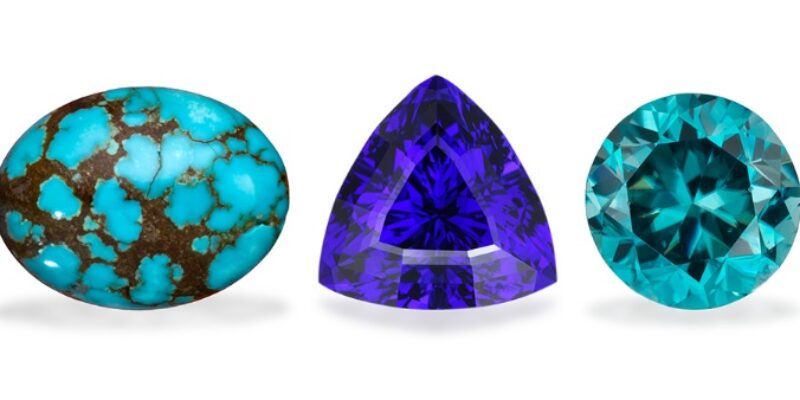
December – The Month of Blue Gemstones
Leave your thoughtsMany Options for December
Think “BLUE“! Traditionally, Turquoise and Lapis Lazuli were the birthstones for December, but modern lists contain Blue Zircon, Blue Topaz, and Tanzanite as other options.
Turquoise History and Lore
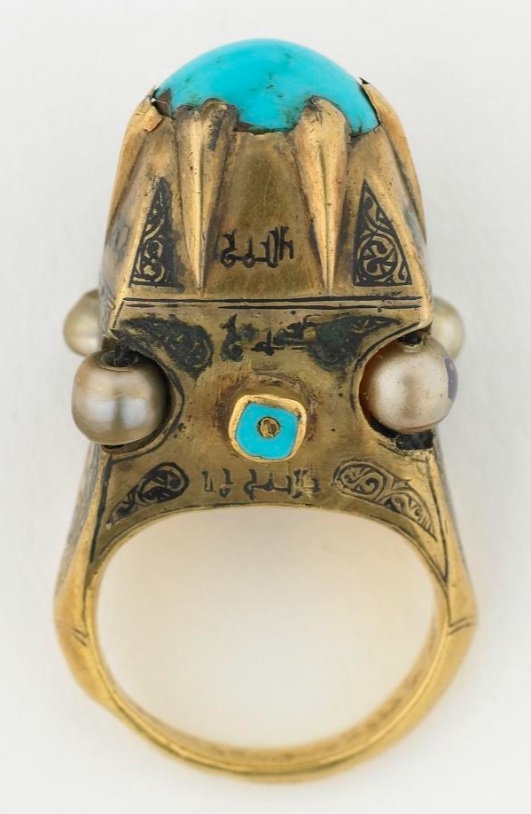
Source: Smithsonian Museum
Turquoise has been used as adornment for centuries, at least as far back as 4000 B.C. Egypt and 10th century Persia (now Iran). Ancient Egyptians called turquoise “mefkat,” which also means “joy” and “delight.” Other ancient people believed it would protect the wearer from falling (especially off horses), and would break into several pieces at the approach of disaster. Hindu mystics maintained that seeing a turquoise after beholding the new moon ensured fantastic wealth.
Persia’s historical Khorasan region was the traditional source of Turquoise for many of the traders in Central Asia and Europe. The trade routes into Europe passed through Turkey and the gem’s name comes from the French expression pierre tourques, or “Turkish stone”, which evolved to become the name we know turquoise by today.
According to Hole et al. (1969), the earliest Persian turquoise artifacts were discovered in the Deh Luran Plain in western Iran. Radiocarbon dating suggests that turquoise beads found in burial sites from the Ali Kosh and Mohamad-Djaffar zones date back to 7000 BCE and 6500 BCE, respectively (see GIA Article for more).
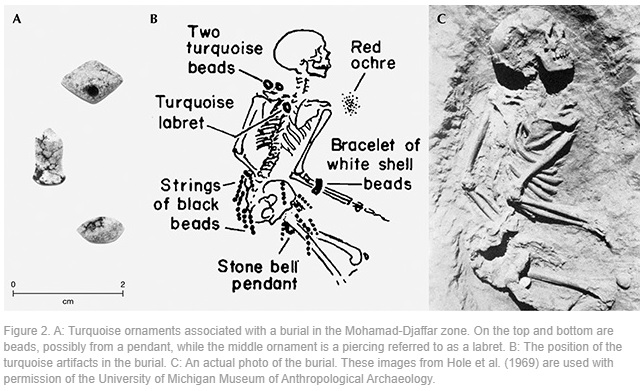
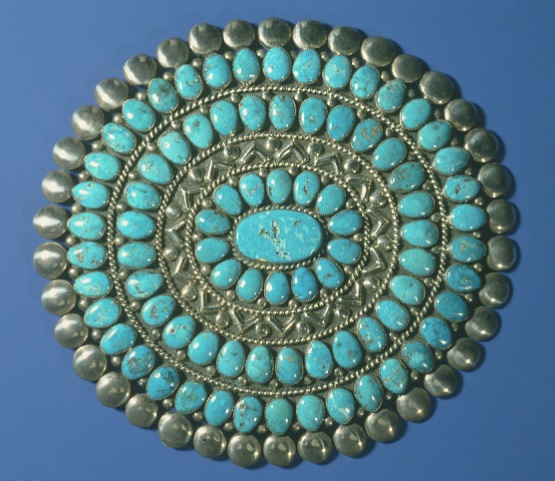
Source: Smithsonian Museum
Turquoise also plays an important role in the lives of Native Americans. The Apache thought turquoise could be found by following a rainbow to its end. They also believed that attaching it to a bow or firearm made one’s aim more true. Pueblo people maintained that turquoise got its color from the sky, while the Hopi thought the gem was produced by lizards scurrying over the earth. Montezuma, thinking Cortes was Quetzalcoatl, gave him the god’s favorite gem: turquoise!
Turquoise Facts
Turquoise is found in only a few places on earth: dry and barren regions where acidic, copper-rich groundwater seeps downward and reacts with minerals that contain phosphorus and aluminum. The result of this sedimentary process is a porous, semi-translucent to opaque compound of hydrated copper and aluminum phosphate. Today, the American Southwest, Tibet, and China are major producers of turquoise, as well as Iran.
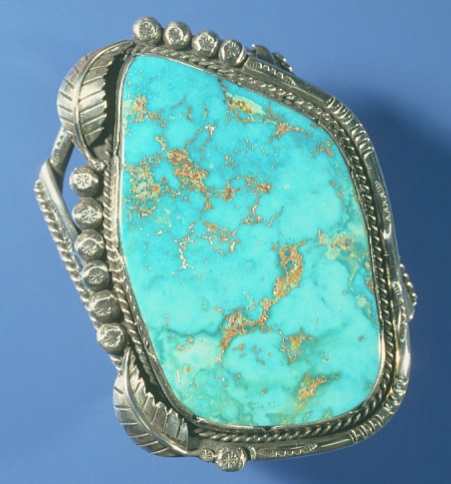
Source: Smithsonian Museum
Turquoise is relatively low on the Mohs hardness scale, 5-6, making natural turquoise prone to damage. Softer turquoise is often “stabilized”, a process that heat treats and impregnates it with a resin to make it tougher. Stabilized turquoise is still considered “real” turquoise, and may be color enhanced. Buyers need to be educated when buying turquoise – howlite and magnesite are sometimes dyed to resemble turquoise, and products labeled “cultured” are made by mixing crushed stone with epoxy. This December birthstone should never be cleaned with steam or ultrasonic cleaners. Heat or solvents can damage the treated surfaces on some turquoise.
Turquoise can range in color from blue to green with matrix that varies from brown to black. Sleeping Beauty turquoise is relatively matrix free, while Number 8 and Kingman can contain quite a bit of matrix. SFJS sources turquoise from reputable mines and we have a map available of mines in the USA.
In addition to being a birthstone for December, turquoise is also traditionally presented as a gift to commemorate the 11th wedding anniversary.
Tanzanite History and Lore
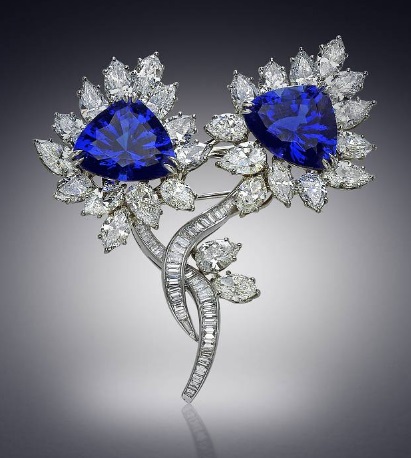
Source: Smithsonian Museum
One of the most exciting gem discoveries of the 20th century, blue stones emerging from Tanzania were identified as the mineral zoisite in 1962. Tanzanite is believed by some to facilitate a higher consciousness, intuition, and perception. Its blue color is also thought to bring calmness to the wearer. It is often described as “velvety,” mostly because of its deep and saturated color, which ranges from a pure rich blue to violet, with the blue considered most valuable.
Tanzanite’s discovery tells of Maasai herders who found blue crystals in the Merelani Hills near Arusha, Tanzania, while tending livestock in 1967. Initially thought to be sapphire gems, the crystals were soon identified as a vibrant blue variety of zoisite—a mineral that had been around since the early 1800s. Tiffany & Co. recognized this blue gem’s potential to rival more expensive sapphire and agreed to become its main distributor naming the gemstone “tanzanite” to highlight its exclusive geographic origin. They introduced it with a promotional campaign in 1968.
Tanzanite Facts
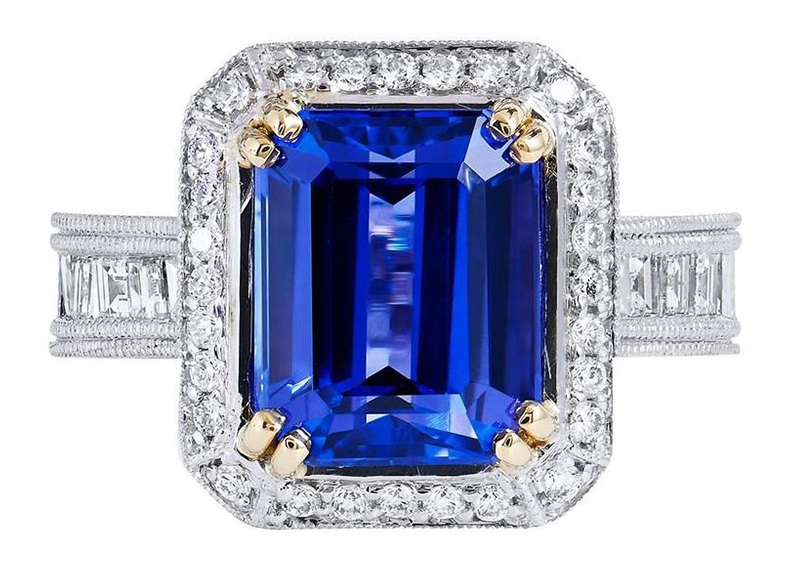
Courtesy GIA/1stdibs.com
Named for its limited geographic origin in Tanzania, tanzanite has quickly risen to popularity since its relatively recent discovery. The Merelani Hills of northern Tanzania are the only place on earth where tanzanite is mined commercially. In the major mechanized operations there, thousands of workers recover tanzanite from mines dug more than 300 feet deep into the earth. The snow-covered slopes of Mount Kilimanjaro tower over the landscape north of the mines.
Today, tanzanite is not only a December birthstone, it is also the gem for the 24th wedding anniversary. Its rating of 6 to 7 on the Mohs scale of hardness makes it resistant to the effects of normal heat, light, and common chemicals. Even so, it may crack if exposed to very high temperatures or sudden temperature changes, and it abrades easily. It is best set in earrings or pendants. Hydrochloric and hydrofluoric acids can etch the surface. Warm, soapy water is the best way to clean this December birthstone.
Blue Zircon History and Lore
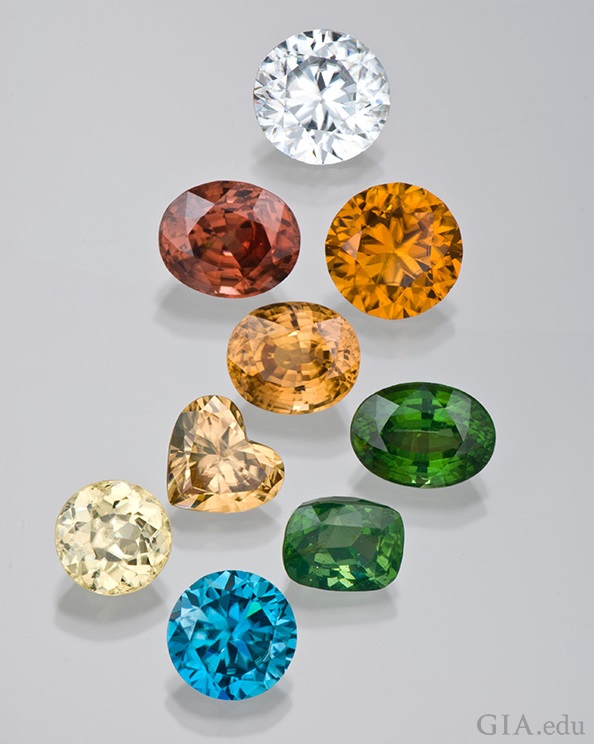
Courtesy Robert Weldon/GIA
The origins of the word “zircon” elicit debate. Some scholars believe it comes from the Arabic word zarkun, meaning “cinnabar” or “vermilion.” Others think the source is the Persian word zargun, or “gold colored.” Considering the broad color palette for this December birthstone – red, orange, yellow, brown, green and blue – either derivation seems possible. Colorless zircon is known for its brilliance and flashes of multicolored light, called fire, which have resulted in centuries of confusion with diamond.
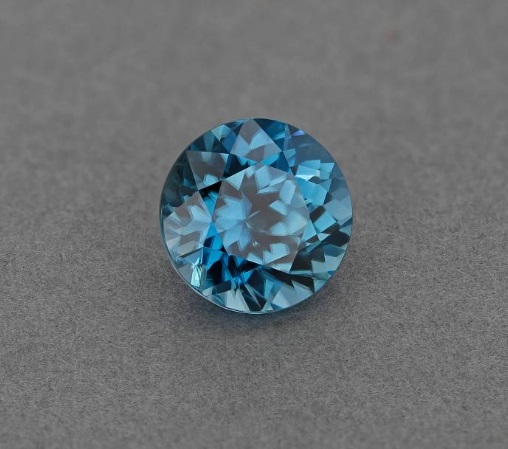
Source: Smithsonian
During the Middle Ages, this December birthstone was thought to lull one into a deep sleep, and scare off evil spirits. In the Hindu religion, zircon alternates with hessonite garnet as one of the nine gems of the navaratna that protect the wearer and bring wealth, wisdom, and good health.
Zircon Facts
Zircon is the oldest mineral on Earth and contains important clues about the formation of our planet. Colorless zircon, known as Matura Diamond, displays brilliance and flashes of multicolored “fire” that can rival fine diamond with one key difference – Zircon is more brittle and its faceted edges can chip.
This December birthstone is often located near sapphire sources. In addition to Sri Lanka and Australia, countries where the two gems overlap include Myanmar, Vietnam and Cambodia. Sri Lanka’s wealth of gems is legendary and includes zircon, sapphire, ruby, alexandrite, spinel, tourmaline, moonstone, and quartz. Elahera, a region in central Sri Lanka, is one of the country’s most productive areas.
With a hardness of 6-7.5 on the Mohs scale, zircon is It is commonly heat treated to produce blue and colorless varieties. Zircon is generally stable, but some heat-treated stones may revert to their original colors if exposed to prolonged heat or light. Clean zircon using a soft brush and mild soap in warm water. Ultrasonic and steam cleaners are not recommended for this December birthstone. It is also best not to wear zircon in rough conditions.
In addition to being a birthstone for December, zircon are sometimes presented as gifts to commemorate the 11th wedding anniversary.
Please visit the SFJS showroom to see our collection of turquoise, lapis lazuli, tanzanite, and other blue gemstones.

